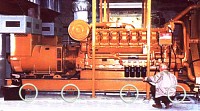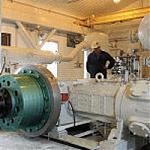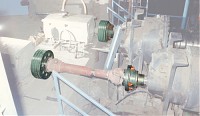
With the higher rotative speeds of modern machines, it is only rarely necessary to provide more than 2 inches of static deflection in undamped vibration isolators. The vertical (theoretical) natural frequency, 133 cpm (165 modified) – corresponding to 2″ deflection – provides adequate vibration isolation (88%) to machinery operating in excess of 500 rpm. At 600 rpm this modified deflection theoretically provides 92% isolation, and for 1200 rpm, 98%.
It is common to the industry now to provide about 1 inch of static deflection in steel-spring isolators. This provides approximately 235 cpm modified and 82% isolation at 600 rpm and 96% at 1200 rpm.
The photo above is a 1300 K.W. Diesel Generator mounted on eight Lo-Rez BR4-LS Isolators in an electrical utility building. This application is rated for seismic conditions in the city of Vancouver. These isolators by themselves provide completely secure seismic restraint.


Just as linear vibration (transmission) can be controlled by inserting ‘soft’ flexible elements (vibration isolators) between the vibrating machine and the floor, so in Torsional (twisting) Vibration control, a flexible element (coupling) between two machines, or portions of a machine, can prevent the torsional excitation from one machine passing into the other machine. An example is the motor-driven reciprocating compressor shown, where the low-order high intensity critical(s) are tuned down well below the minimum operating rpm by means of a torsionally – soft Lo-Rez H2/HF coupling.
Reciprocating Compressors, as used in oil and gas production, pipeline transmission and in large chemical and refinery processing plants can generate very high levels of harmonic torque on their crankshafts. While some of these higher-order resonant torques can be safely controlled by the inherent damping capacity of the crankshaft mechanism (or by the addition of a viscous damper), the lower-order torque harmonics (1.0, 2.0, 3.0) which are often highly-unbalanced, have to be suppressed externally or detuned below the minimum operating rpm of the system.
The photo below is one of three Ariel JGC-6’s powered thru Lo-Rez I2/HF Steel-Spring Coupling, at Tenneco, Catlettsburg Kentucky.
Lo-Rez torsionally-soft steel-spring flexible couplings are extremely effective in handling these compressor drives, whether motor, turbine or engine-driven. By reason of the constant, reliable and torsional stiffness values in these couplings, the primary natural frequency of the power train can be confidently and precisely placed well below the operational rpm so that the serious 1.0 and/or 2.0 and/or 3.0 order torque harmonics can be significantly reduced, with the total vibratory torque on the system controlled to within +/- 20% of mean torque over the operating speed range.

Cement Mill grinding machines (Fuller design), which utilize a fixed roll and also a moveable roll head, are often equipped with two Lo-Rez steel-spring couplings (to absorb moderate shock loads) plus two Lo-Rez Torque Limiters to disengage when severe torque spikes occur due to grinding head blockage.